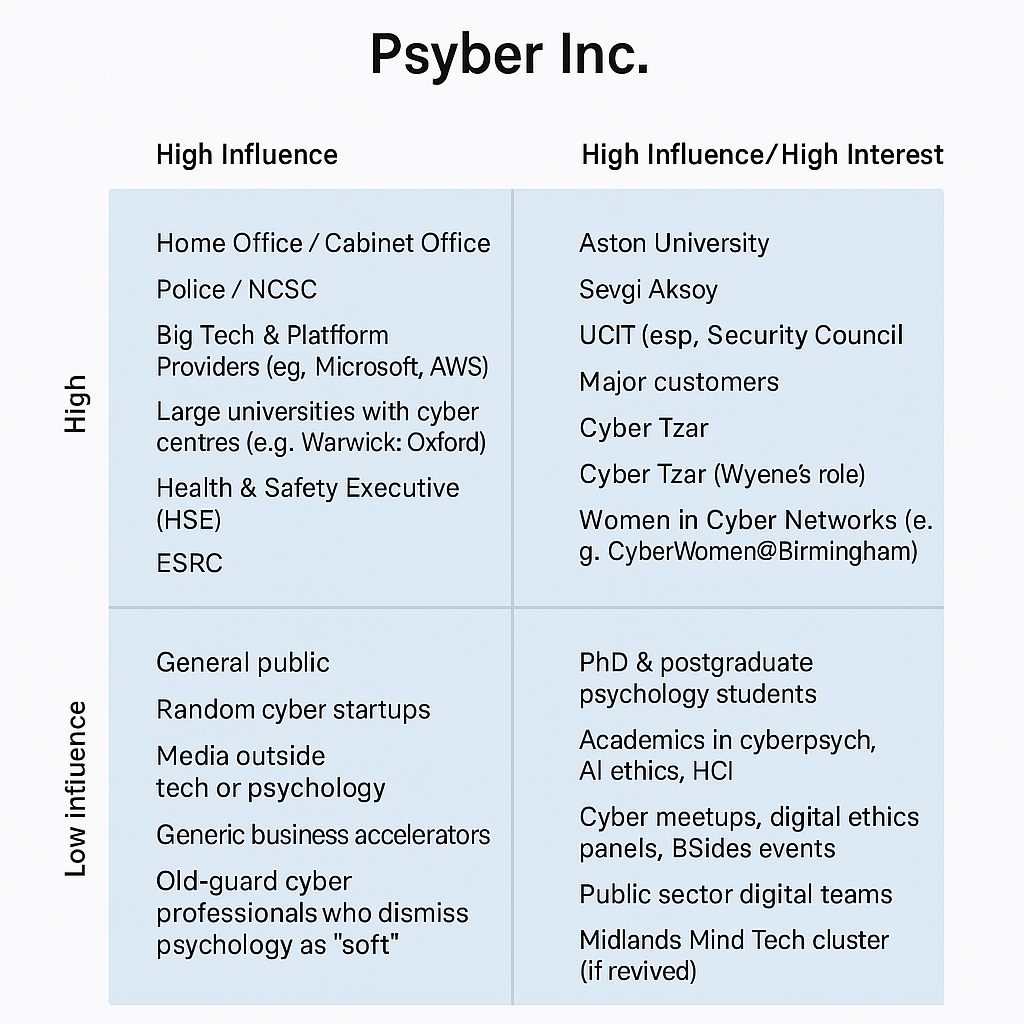Navigating influence in a new and emerging field like cyber psychology requires clarity, confidence, and strategic alignment. As a startup working at the intersection of AI ethics, human factors, and cybersecurity resilience, Psyber Inc. operates in a diverse and sometimes opaque stakeholder landscape.
This article outlines how Psyber Inc. applies the Stakeholder Mapping Grid to identify and prioritise its most important audiences, from universities and policy players to community networks and institutional gatekeepers. The result is a living blueprint for managing influence and interest as the company grows.
This article is with thanks to Robin Kennedy and Emma Fadlon of Innovate UK, based on my time with the academic leaders on the 2025 CyberASAP cohort. Thank you!
1. Manage Closely (High Influence / High Interest)
Strategic relationships and key decision-makers
- Aston University – PhD partnership and cyber psychology research
- Sevgi Aksoy – Head of Research and brand ambassador
- DSIT (Skills & Professionalisation team) – potential funder and policy shaper
- Innovation Alliance West Midlands (IAWM) – key regional convenor and enabler
- UK Cyber Security Council – setting frameworks for human-centric security
- Cyber Tzar – synergy on scoring, modelling, and patent IP
- Women in Cyber networks – e.g., CyberWomen@Birmingham, with shared focus on inclusion and leadership
- Royal Academy of Engineering (RAEng) – linking behavioural science and engineering systems thinking
2. Keep Satisfied (High Influence / Low Interest)Powerful stakeholders not yet actively engaged
- Home Office / Cabinet Office – strong influence over national resilience, but startup engagement is limited
- Police / NCSC – interested in outcomes like insider threat mitigation, less engaged in behavioural modelling
- Big Tech & cloud platforms – e.g., Microsoft, AWS – potential partners but currently unaware
- Large universities with cyber centres – e.g., Warwick, Oxford – are influential but may see Psyber as peripheral
- Health & Safety Executive (HSE) – human factors relevance, but not cyber-focused
- British Psychological Society (BPS) – influences the profession, but not innovation-led
- ESRC – high-value funding source, but no current alignment
3. Keep Informed (Low Influence / High Interest)
Supporters, researchers, and emerging advocates
- PhD & postgraduate students – potential collaborators and amplifiers
- Academics in cyberpsychology, HCI, AI ethics – ideal research partners or peer reviewers
- Cyber meetups, digital ethics panels, B-Sides events – aligned values, grassroots energy
- Public sector digital teams – interest in usability, cognitive load, and behaviour
- Midlands Mind Tech cluster – if revived, a natural partner on mental health and cyber
- STEM outreach groups and social science think tanks
- Smaller charities – focused on digital harm, wellbeing, or online safety
4. Monitor (Low Influence / Low Interest)
Minimal engagement unless activated
- General public – unless reached through public campaigns or news stories
- Random cyber startups – unless directly targeted for modelling or research
- Media outside tech/psychology – unless there’s a strong human-interest angle
- Generic business accelerators – unless they focus on deep tech or social impact
- Old-guard cyber professionals – who may dismiss psychology as “soft”, not your audience (yet)
Summary
Psyber Inc.’s stakeholder map reflects its hybrid academic-commercial model. With a focus on relationship quality over quantity, this grid helps ensure time and energy are directed where they’ll make the biggest difference, whether that’s influencing national frameworks, building academic credibility, or building a voice in underserved spaces.
